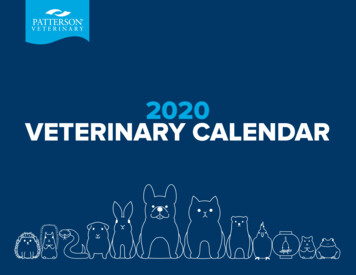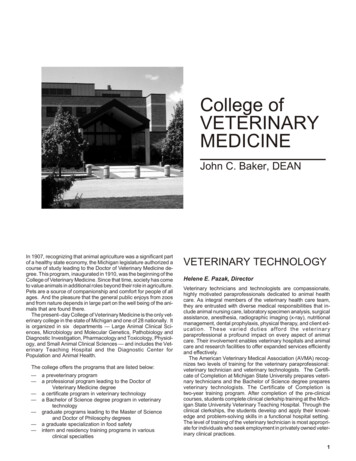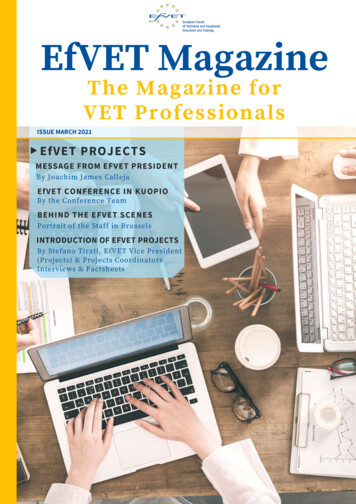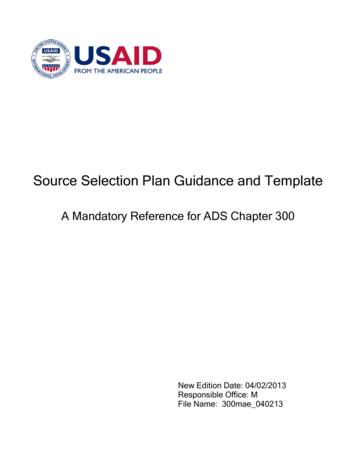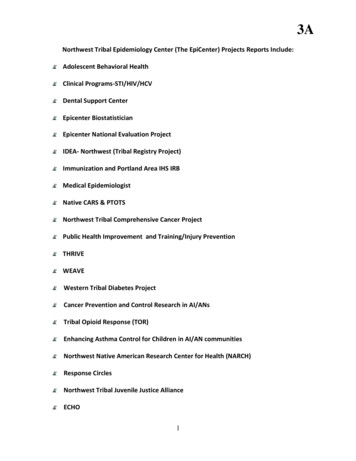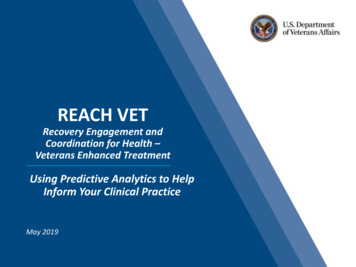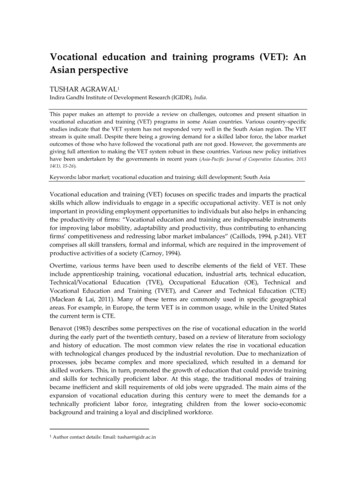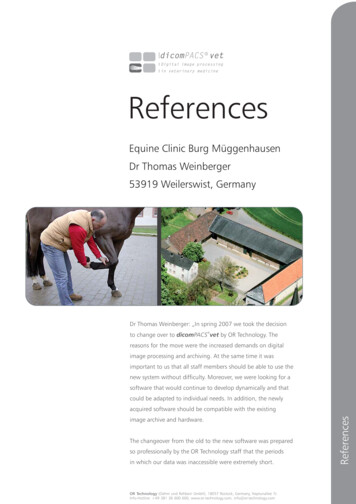
Transcription
VET TEC CERTIFYING OFFICIAL HANDBOOKDepartment of Veterans AffairsVolume 1.0May 2019
Table of ContentsPREFACE . 3ABOUT THIS HANDBOOK . 3INTENDED AUDIENCE . 3QUESTIONS AND SUGGESTIONS . 3ACKNOWLEDGEMENTS . 3WHAT IS VET TEC?. 4APPLYING TO BE A VET TEC TRAINING PROVIDER . 5INITIAL APPROVAL OF VET TEC PROGRAMS . 5ANNUAL REAPPROVAL OF VET TEC PROGRAMS. 5TRAINING PROVIDER RESPONSIBILITIES . 6TRAINING PROVIDER RESPONSIBILITIES . 6RESPONSIBILITIES FOR REPORTING . 9ENCOURAGED RESPONSIBILITIES . 9STUDENT RESPONSIBILITIES . 11PAYMENTS AND DEBTS . 12PAYMENTS MADE TO THE TRAINING PROVIDER . 12PAYMENT SCHEDULE FOR TUITION AND FEE PAYMENTS MADE TO THE TRAINING PROVIDER . 13ASSESSING TUITION AND FEES CHARGES . 14PAYMENTS MADE TO THE STUDENT VETERAN . 14DEBTS MADE TO THE TRAINING PROVIDER . 15DEBTS MADE TO THE STUDENT VETERAN . 16REFUND POLICIES AND RETURNING MONIES TO THE VA. 17IMPROPER PAYMENTS ELIMINATION AND RECOVERY ACT. 19SAMPLE E-MAIL A TRAINING PROVIDER MAY RECEIVE . 1985-15 RATIO . 20COMPUTING THE 85-15 RATIO . 201.DETERMINING WHEN SEPARATE COMPUTATIONS ARE REQUIRED: . 202.ASSIGNING STUDENTS TO EACH PART OF THE RATIO: . 203.CALCULATION: . 21REPORTS . 21VIOLATION OF 85-15 PERCENT REQUIREMENT . 221 Page
PREFERRED PROVIDERS AND THE 85-15 PERCENT REQUIREMENT . 22INEQUITY OF CHARGES . 23COMPLIANCE SURVEYS . 25WHAT IS A COMPLIANCE SURVEY? . 25VA AUTHORITY TO REVIEW RECORDS. 25CONTENT AND ORGANIZATION OF VA STUDENT FOLDERS . 25APPENDIX A: CERTIFYING OFFICIAL RESOURCES . 26CONTACT INFORMATION FOR VET TEC APPROVAL, COMPLIANCE, AND LIAISON TEAM. 26CONTACT INFORMATION FOR VET TEC PROCESSING TEAM . 26APPENDIX B: VA ONLINE RESOURCES . 27APPENDIX C: VA ACRONYM GUIDE . 28APPENDIX D: EXAMPLE VET TEC COE . 29APPENDIX E: STATEMENT OF ASSURANCE OF COMPLIANCE WITH 85-15 PERCENT RATIOS . 33APPENDIX F: BLANK COPY OF PARTICIPATION AGREEMENT FOR THE FISCAL YEAR . 342 Page
PREFACEABOUT THIS HANDBOOKThis handbook was developed by the Department of Veterans Affairs (VA) and provides comprehensiveinstructions for Training Providers on the process of applying for the Veteran Employment throughTechnology Education Courses (VET TEC) Pilot Program and provides detailed information on theresponsibilities of Training Providers approved for VET TEC.INTENDED AUDIENCEThis handbook is designed primarily for the designated Certifying Official at an approved VET TECTraining Provider site. Senior leadership of the Training Provider site should also be kept aware of thishandbook as it outlines the rules and requirements of the VET TEC Pilot Program.QUESTIONS AND SUGGESTIONSRequests for clarification about information supplied in this handbook, or how it can be improvedshould be submitted to ELR-VETTEC.vbabuf@va.gov.ACKNOWLEDGEMENTSThis handbook is the product of collaboration between the Eastern Region Approval, Compliance andLiaison Team, the Buffalo Regional Processing Office, and VA Central Office.3 Page
WHAT IS VET TEC?On August 16, 2017, the Harry W. Colmery Veterans Educational Assistance Act of 2017 (commonlyknown as the “Forever GI Bill”) was signed into law. Section 116 of this law (Department of VeteransAffairs high technology pilot program) authorized the Veteran Employment through TechnologyEducation Courses (VET TEC) Pilot Program.The VET TEC Pilot Program’s goal is to offer Veterans an opportunity to study in high technologyprograms of education1 which are approved and paid for by the Department of Veterans Affairs (VA).Section 116 of the Harry W. Colmery Veterans Educational Assistance Act of 2017 allows VA to pay forthe following: Mandatory tuition and fee costs charged by the Training Provider; and A monthly housing stipend equitable to what a student would receive if receiving monthlyhousing allowance (MHA) under the Post-9/11 GI Bill Benefit (Chapter 33).Further information about how VA pays Training Providers and student Veterans under the VET TEC PilotProgram can be found in the Payments and Debts section.The VET TEC Pilot Program is authorized for 5-years with an annual budget of 15,000,000.00 for tuition,fees, and monthly housing stipend payments.VA centralized all Training Provider approval actions to the Eastern Region Approval, Compliance andLiaison Team, and all Claims Processing actions to the Buffalo Regional Processing Office (RPO).1High technology programs of education are specifically defined by the Harry W. Colmery Veterans EducationalAssistance Act of 2017 as “one that provides instruction in computer programing, computer software, mediaapplication, data processing, or information science”.4 Page
APPLYING TO BE A VET TEC TRAINING PROVIDERINITIAL APPROVAL OF VET TEC PROGRAMSA Training Provider that seeks to have its programs approved for the VET TEC Pilot Program must submitthe VET TEC Pilot Program Training Provider Application, the VET TEC Pilot Program ParticipationAgreement, and required supporting documentation to the Eastern Region Approval, Compliance andLiaison Team.These documents can be submitted through email at: ELR-VETTEC.vbabuf@va.gov.OrThese documents can be submitted through postal mail to:VET TEC Application7th Floor130 South Elmwood AveBuffalo NY 14202ANNUAL REAPPROVAL OF VET TEC PROGRAMSAll approved Training Providers will need to submit a reapproval package to maintain their participationin VET TEC. The reapproval package will be released by the Eastern Region Approval, Compliance, andLiaison Team to approved Training Providers electronically.5 Page
TRAINING PROVIDER RESPONSIBILITIESTRAINING PROVIDER RESPONSIBILITIES1. The Training Provider must ensure that they are in compliance with:a. Title VI, Civil Rights Act of 1964,b. Title IX, Education Amendments of 1972,c. Section 504, Rehabilitation Act of 1973, andd. The Age Discrimination Act of 1975In accordance with these provisions the Training Provider cannot restrict eligible studentVeterans from using VET TEC to pay for an approved program they are eligible to attend.Training Providers cannot restrict access to an approved program to a student Veteran, whomeets all mandatory entrance requirements, due to the student’s race, national origin, gender,gender identity, sexual orientation, disability, or age.2. The Training Provider must ensure that contact information for all Certifying Officials alwaysremains current.a. If the contact information for a Certifying Official changes (email address changes,phone number changes, etc.), the change must be immediately reported by sending anemail to the VET TEC Education Liaison Representative (ELR).b. If there is a change in Certifying Official(s) (the Training Provider adds, removes, orreplaces Certifying Officials), the Training Provider must immediately submit a newDesignation of Certifying Official(s) form (VA Form 22-8794).3. The Training Provider will report all changes to approved programs (i.e., change in the cost oftuition and fees, change in program length, change in number of credit or clock hours neededfor a student to be considered full time, change to the Training Provider’s tuition refund policy,etc.) to the VET TEC ELR within 30 calendar days of the change. The Training Provider mustreport, and receive an updated approval letter from the VET TEC ELR, before they can certifynew student Veterans into the altered program.4. If the approved program has more than one course (or module), then the Training Provider mustensure that only courses (or modules) that satisfy requirements outlined by the curriculumguide or graduation evaluation can be certified to the VA for reimbursement. A curriculum guideor graduation evaluation form must be kept in each student Veterans’ file. If a student Veterantakes a course that does not fulfill a program requirement, it cannot be certified for VAreimbursement.5. The Training Provider must submit all VA enrollment certifications and any amendments,adjustments, or terminations through the VA Online Certification Enrollment (VA-ONCE) system.6 Page
a. Enrollments must be submitted no earlier than 14 calendar days of the studentVeteran’s start date. Enrollments should only be submitted if the student has provided acopy of their VET TEC specific Certificate of Eligibility (COE).b. Amendments, adjustments, and terminations must be submitted within 30 calendardays of the date the amendment, adjustment, or termination occurred.**NOTE: This is not the date that the Certifying Official was informed of the change inenrollment status; the change must be reported within 30 days of the actual change inenrollment status.6. The Training Provider must submit the Verification of Meaningful Employment form to theBuffalo RPO via email, postal mail, or fax once the student Veteran secures meaningfulemployment.7. The Training Provider must certify all mandatory Tuition and Fees for student Veterans.Mandatory Tuition and Fees are defined in the Payments and Debts section.8. The Training Provider must ensure that all advertising materials used are not erroneous ormisleading, either by actual statement, omission, or intimation2.a. The Training Provider may, if desired, mention in its advertising that its programs havebeen approved by VA to receive reimbursement under the VET TEC Pilot Program. Thisadvertising must specifically list the programs approved (unless all programs areapproved) and must use verbiage similar to “approved by the Department of VeteransAffairs to receive reimbursement under the VET TEC Pilot Program”. The TrainingProvider may not simply state that their programs are “VA Approved”. 9. The Training Provider must ensure that the VA trademark symbol ‘‘ ’’ is placed at the upperright corner of the trademarked phrase “GI Bill” in the most prominent place at first usage; suchas the title of a brochure, form, or the very top of a Web page. The following trademarkattribution notice must also be prominently visible:‘‘GI Bill is a registered trademark of the U.S. Department of Veterans Affairs (VA). Moreinformation about education benefits offered by VA is available at the official U.S.government Web site at https://www.benefits.va.gov/gibill."This trademark must be used in all print, electronic, radio, digital, or other media applicationsused by the Training Provider. Additional information about the VA Trademark can be found athttps://www.benefits.va.gov/GIBILL/Trademark Terms of Use.asp.As noted above, for electronic sources the trademark symbol and trademark notice must appearon each Web page where the trademarked phrase is used. This means that if a Training2Intimation is the action of making something known through indirect means.7 Page
Provider’s Website contains multiple Web pages where the trademark is used, the trademarksymbol and trademarked phrase must be listed on each of those Web pages.10. The Training Provider must maintain student records for a minimum of 3 years followingstudents’ last date of attendance. These records must be maintained in a safe place, and theprivacy of students’ information must be ensured.a. Each record must contain all the student’s pertinent forms. Examples of documents theTraining Provider should maintain include:i. Copies of all VA paperworkii. Student’s initial applicationiii. Student’s enrollment contractiv. Student’s transcripts from previous schools if any credit was used to shorten thestudent’s termv. Student’s transcriptvi. Student’s grade reportsvii. Student’s drop slips or evidence of changes in enrollment statusviii. Student’s registration slipsix. Student’s record of tuition and fees chargesx. Records of disciplinary actions against the studentxi. Student’s evaluation formxii. Student’s Verification of Meaningful Employment form11. The Training Provider must furnish a copy of the course outline, schedule of tuition, fees, andother charges, regulations pertaining to absences, grading policy, and rules of operation andconduct to each student Veteran.12. If a student Veteran has received comparable training previously, and the Training Provider willaccept this prior training to shorten their training time, then the Training Provider must notatethis in the student Veteran’s file. Additionally, the Training Provider must proportionally shortenthe enrollment period when submitting the term to the VA.13. The Training Provider must provide all specified documentation (for both student Veterans andnon-student Veterans) to duly authorized representatives of the Government when requested.8 Page
14. The Training Provider must ensure that all Certifying Officials attend any mandatory VET TECspecific training offered by VA.15. The Training Provider must ensure that their training site remains in compliance with the 85-15percent ratio3.16. The Training Provider must ensure that there are no commissions, bonuses, or other incentivepayments based, directly or indirectly, on success in securing enrollments or financial aid to anypersons or entities engaged in any student recruiting or admission activities or in makingdecisions regarding the award of student financial assistance.17. The Training Provider must ensure that all refunds due to student Veterans are promptlyreleased to the student or returned to VA.RESPONSIBILITIES FOR REPORTING1. The Certifying Official must keep the VA informed of the enrollment status of student Veterans.Changes in the student Veteran’s enrollment status must be reported to VA within 30 calendardays of the change.2. The Certifying Official must monitor student Veteran’s grades to ensure satisfactory progress isbeing made.3. The Certifying Official must monitor students’ conduct and report if a student Veteran issuspended or dismissed for unsatisfactory conduct.ENCOURAGED RESPONSIBILITIESThe following list contains additional activities that the Training Provider is encouraged to carry out, butis not required to do.1. Annually, VA will be conducting market research meant to enhance the VET TEC Pilot Programand better understand the organizational capabilities of approved, or interested, TrainingProviders. The Approved Training Provider should complete the Request for Information (RFI)released by VA. Approved Training Providers will be notified of the RFI by the VET TEC ELR.2. The Training Provider should assist interested Veterans in applying for the VET TEC PilotProgram if they have not already done so. Interested Veterans should apply on the VA.govWebsite.3. The Training Provider should assist student Veterans that graduate with finding meaningfulemployment.4. The Training Provider should disseminate information on the VET TEC Pilot Program and Veterancontact points to student Veterans.3Preferred Providers are excluded from this requirement.9 Page
5. The Training Provider should ensure that student Veterans are fully aware of theirresponsibilities to the school.6. The Training Provider should stress to student Veterans that they must continue their trainingon a full-time basis or their enrollment in the VET TEC Pilot Program will be terminated.7. The Training Provider’s Certifying Official should keep their supervisor(s) apprised of any internalproblems that may affect service to student Veterans in VET TEC. Examples of this include:a. Failure of records office to provide timely information on a student Veteran’s grades,grade changes, or academic problems.b. Failure of instructors to provide information on attendance or attendance problems forstudent Veterans.c. Failure of other offices to provide information on changes to a program approved by VAto receive VET TEC funds.d. Failure of the mail distribution center to timely forward appropriate mail.10 P a g e
STUDENT RESPONSIBILITIES1. In order to be eligible for the VET TEC Pilot Program, Veterans4 must first submit an applicationto VA. If a Veteran is unsure if they are eligible for the VET TEC Pilot Program, they shouldsubmit a formal application.2. Student Veterans must provide a copy of their VET TEC specific COE to their Training Provider.3. Student Veterans must attend the program on a Full-Time basis.4. Student Veterans must follow all Training Provider policies and rules pertinent to their programof study. This includes all employment searching policies and rules required after the studentVeteran graduates.5. Student Veterans will need to verify their continued enrollment monthly with the VA.Information on how they can verify their continued enrollment will be found on the GI BillWebsite.6. Student Veterans must notify the Training Provider when they find meaningful employment bysigning and submitting the Verification of Meaningful Employment form.7. Student Veterans must ensure that they keep their address up to date with VA. StudentVeterans can report changes to their address by contacting VA.8. Student Veterans must ensure that they keep their direct deposit information up to date withVA. Student Veterans can report changes to their direct deposit information by contacting VAand providing:a. Their new account number.b. Their new 9-digit routing number.c. The type of account (checking or savings).4Section 116 of Public Law 115-48 requires that Veterans meet the following criteria to be eligible to receivetuition and fees or housing stipend payments under the VET TEC Pilot Program: Individuals must be a Veteran.o Active duty Servicemembers, recipients of Transfer of Entitlement (TOE) benefits, and recipientsof the Marine Gunnery Sergeant John David Fry Scholarship (Fry Scholarship) are not eligible forthe VET TEC Pilot Program.The Veteran must be entitled to educational assistance under Chapter 30, 32, 33, 34, or 35 of Title 38,United States Code (USC), or Chapter 1606 or 1607 of Title 10 USC. This means that they must have atleast 1 day of entitlement remaining under one of these benefit chapters.11 P a g e
PAYMENTS AND DEBTSPAYMENTS MADE TO THE TRAINING PROVIDERThe Training Provider is eligible to receive payment for mandatory tuition and fees charges up to thePost-9/11 GI Bill private school tuition and fees cap5.1. Tuition is defined as: The actual established charges for tuition that the student Veteran isrequired to pay. Tuition is defined in the Training Provider’s catalog (or supplement) and mustbe listed as “Tuition” on the Training Provider’s billing statement or invoice.2. Fees are defined as: Mandatory charges6 (other than tuition, room, board, transportation, orfood) charged by the Facility for pursuit of an approved program. Fees include, but are notlimited to, health premiums, graduation fees, or lab fees. Fees are defined in the Facility’scatalog and are listed on the Facility’s billing statement or invoice.**NOTE 1: Assessment fees (which are charged to every student) are payable if the studentVeteran is accepted into (and attends) the approved program.**NOTE 2: VA is exempt from sales tax, and will not reimburse sales tax in any instance.Examples of fees that are not allowed include, but are not limited to: Penalty Fees (late registration, late course changes, or returned checks)Fees for any food or lodging expensesTransportation or transit system feesParking fees that are not required for every student5Preferred Providers are not held to this tuition and fees cap. If the Training Provider is exempt from this cap thenit will be expressly noted in the approval letter received from their initial VET TEC application.6A mandatory charge is a standard charge that is applied to all students, without exception. If there is even oneexception, the charge is not considered mandatory.Example: All students must have a certain brand of laptop for their program. If all students must purchase this laptop from the Training Provider for 1,000.00, then the fee ismandatory and the charge can be made to VA for all student Veterans. If the students may purchase this laptop from the Training Provider for 1,000.00, or can independentlypurchase the laptop from a 3rd party retailer, then the fee is not mandatory and the charge cannot bemade to VA for any student Veteran. If all students must purchase this laptop from the Training Provider for 1,000.00, but a student alreadyhas the laptop so the Training Provider waives the 1,000.00 charge for that student, then the fee is notmandatory and the charge cannot be made to the VA for any student Veteran.12 P a g e
**NOTE 1: VA is considered “Last Payer”. This means that when certifying tuition and fees to VA, aTraining Provider must first consider any tuition and fees specific scholarship,Federal/State/Institutional/Employer aid or assistance (excluding loans or Title IV funds) that areprovided directly to the institution and specifically designated for the sole purpose of defraying tuitionand fees costs.**NOTE 2: The tuition and fees charged and collected from student Veterans for an approved programmust be equal to or less than the tuition and fees charged and collected from similarly circumstancednon-veteran students who are not receiving assistance under the VET TEC program.Example:Tuition and Fee ChargesVeteran DiscountTuition ScholarshipGeneral ScholarshipTotal Amount Chargeable to the Department ofVeterans Affairs 10,000.00 500.00 1,500.00 1,000.00 8,000.00 10,000.00 tuition and fee charges- 500.00 Veteran discount from the Training Provider- 1,500.00 for the tuition specific scholarship 8,000.00 remaining which can be charged to theDepartment of Veterans Affairs.Because the 1,000.00 General Scholarship is not tuitionand fees specific, it must be refunded to the student.PAYMENT SCHEDULE FOR TUITION AND FEE PAYMENTS MADE TO THETRAINING PROVIDERSection 116 of Public Law 115-48 obligates the Department of Veterans Affairs to pay tuition and feesbased on the following milestones (this payment schedule will routinely be referred to as the “25/25/50Rule”): 25% of the submitted tuition and fees will be paid to the Training Provider upon the initialenrollment of the student Veteran.oNote: “initial enrollment” requires the student Veteran to attend at least one day ofclass. 25% of the submitted tuition and fees will be paid to the Training Provider upon the studentVeteran’s successful completion of the program. 50% of the submitted tuition and fees will be paid to the Training Provider once the studentVeteran has found meaningful employment.13 P a g e
oNote: “meaningful employment” is defined as: Traditional employment in a career the program of study was in. Promotion in the student Veteran’s current career if the student Veteran iscurrently employed in a career the program of study was in. Self-Employment if the student Veteran is owning/operating a business and isutilizing the skills from the program of study they were in.ASSESSING TUITION AND FEES CHARGESVA pays according to the 25/25/50 Rule outlined above. When assessing charges, the Training Providermust consider all charges covered by the VA if the student is enrolled in an approved program andactively using VET TEC.Example:A Training Provider has mandatory tuition and fees charges of 10,000.00.A student using VET TEC would be paid at the following intervals: 2,500.00 (25% of the total tuition and fees charges) upon the initial enrollment of the student. 2,500.00 (25% of the total tuition and fees charges) upon the student’s successful completionof the program 5,000.00 (50% of the total tuition and fees charges) upon the student finding meaningfulemployment.A Training Provider cannot receive the initial VET TEC payment of 2,500.00 and then charge thestudent Veteran 7,500.00 with the intent to refund future VET TEC tuition and fees payments to thestudent. Payments will be made, by VA, at the identified VET TEC milestones.**NOTE: If a student withdraws from the program then, at that time, the Training Provider may, at theirdiscretion, assess any outstanding tuition and fees charges against the student.PAYMENTS MADE TO THE STUDENT VETERANStudent Veterans are eligible to receive a monthly housing stipend which is paid directly to them. Thispayment will be made to the student Veteran in arrears (i.e. if a student Veteran began attendingtraining in May, they will not receive their first monthly housing stipend until around the first week inJune). Student Veterans need to verify their continued enrollment monthly with the VA to release thispayment.14 P a g e
Monthly housing stipends are determined based on how the student Veteran is taking classes (inresidence VS distance). If a student Veteran has a specific question about their monthly housing stipend,they should contact the VET TEC Processing Team for clarification.The monthly housing stipend is made to the student Veteran for the number of days the studentVeteran is certified for the month. If a student Veteran is certified for a whole month, the full monthlyamount is paid. If the student Veteran is only certified for part of the month, the amount is prorated asfollows: The VA uses a 30-day month. To determine the daily rate, a student Veteran must divide themonthly rate by 30.oExample: If a student Veteran is certified from the 1st through the 15th of a month, thenthey would be entitled to 15/30ths of the full monthly amount.DEBTS MADE TO THE TRAINING PROVIDERVA will create a debt to the Training Provider when: The student Veteran never attended any classes for which they were certified. The student Veteran completely withdraws on or before the first day of term. The Training Provider received payment for the wrong student. The Training Provider received a duplicate payment. The Training Provider submitted an amended enrollment certification and reduced tuition andfee charges. Findings during a Compliance Survey show that an erroneous tuition and fees amount wascertified.When a Training Provider debt is created, the Buffalo RPO will send a letter to the Training Provider,notifying them of the debt (oftentimes ref
a. Enrollments must be submitted no earlier than 14 calendar days of the student Veterans start date. Enrollments should only be submitted if the student has provided a copy of their VET TEC specific Certificate of Eligibility (COE). b. Amendments, adjustments, and terminations must be submitted within 30 calendar
